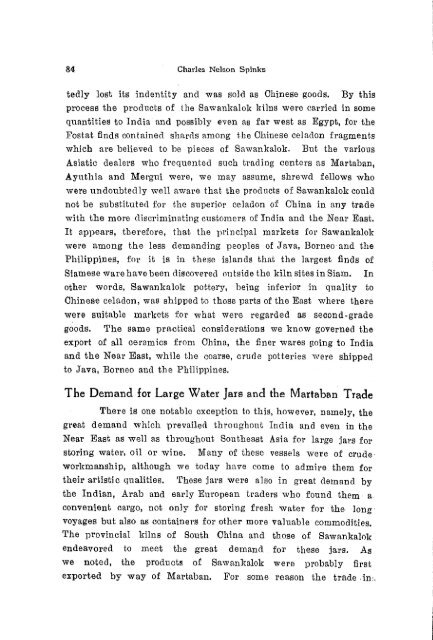The Journal of the Siam Society Vol. XLIV, Part 1-2, 1956 - Khamkoo
The Journal of the Siam Society Vol. XLIV, Part 1-2, 1956 - Khamkoo
The Journal of the Siam Society Vol. XLIV, Part 1-2, 1956 - Khamkoo
You also want an ePaper? Increase the reach of your titles
YUMPU automatically turns print PDFs into web optimized ePapers that Google loves.
84 Charles Nelson Spinks<br />
tedly lost its indentity and was sold as Chinese goods. By this<br />
process <strong>the</strong> products <strong>of</strong> <strong>the</strong> Sawankalok kilns were carried in some<br />
quantities to India and possibly even as far west as Egypt, for <strong>the</strong><br />
Fostat finds contained shards among <strong>the</strong> Chinese celadon fragment.s<br />
which are believed to be pieces <strong>of</strong> Sawanlmlok. But <strong>the</strong> various<br />
Asiatic dealers who frequented such trading centers as Martaban,<br />
Aynthia and Mergui were, we may assume, shrewd fellows who<br />
were undoubtedly well aware that <strong>the</strong> products <strong>of</strong> Sawanlmlok could<br />
not be substituted for <strong>the</strong> s11perior celadon <strong>of</strong> China in any trade<br />
with <strong>the</strong> more discriminating customers <strong>of</strong> India and <strong>the</strong> Near East.<br />
It appears, <strong>the</strong>refore, that <strong>the</strong> principal markets for Sawanlmlok<br />
were among <strong>the</strong> less demanding peoples <strong>of</strong> Java, Borneo and <strong>the</strong><br />
Philippines, for it is in <strong>the</strong>se islands that <strong>the</strong> largest finds <strong>of</strong><br />
<strong>Siam</strong>ese ware have been discovered nu tside <strong>the</strong> kiln sites in <strong>Siam</strong>. In<br />
o<strong>the</strong>r wnrds, Sawanlmlok pottery, being inferior in quality to<br />
Chinese celadon, was shipped to those parts <strong>of</strong> <strong>the</strong> East where <strong>the</strong>re<br />
were suitable markets for what were regarded as second-grade<br />
goods. <strong>The</strong> same practical considerations we know governed <strong>the</strong><br />
export <strong>of</strong> all ceramics from China, <strong>the</strong> flner wares going to India<br />
and <strong>the</strong> Near East, while <strong>the</strong> coarse, crude potteries were shipped<br />
to Java, Borneo and <strong>the</strong> Philippines.<br />
<strong>The</strong> Demand for Large Water Jars and <strong>the</strong> Martaban Trade<br />
<strong>The</strong>re is one notable exception to this, however, namely, <strong>the</strong><br />
great demand which p1•evailed throughout India and even in <strong>the</strong><br />
Near East as well as throughout Sou<strong>the</strong>ast Asia for large jars for<br />
storing water, oil or wine. Many <strong>of</strong> <strong>the</strong>se vessels were <strong>of</strong> crude<br />
workmanship, although we today have come to admire <strong>the</strong>m for<br />
<strong>the</strong>h• artistic qualities, 'rhese jars were also in great demand by<br />
<strong>the</strong> Indian, At•ab and early Enropean traders who found <strong>the</strong>m a<br />
convenient cargo, not only for storing fresh water for <strong>the</strong> long<br />
voyages but also as containers for o<strong>the</strong>r more valuable commodities.<br />
<strong>The</strong> provincial kilns <strong>of</strong> South China and those <strong>of</strong> Sawankalok<br />
endeavored to meet <strong>the</strong> great demand for <strong>the</strong>se jars. As<br />
we noted, <strong>the</strong> product!! <strong>of</strong> Sawan1ralok were probably first<br />
exported by way <strong>of</strong> Martaban. For some reason <strong>the</strong> trade in:.

















